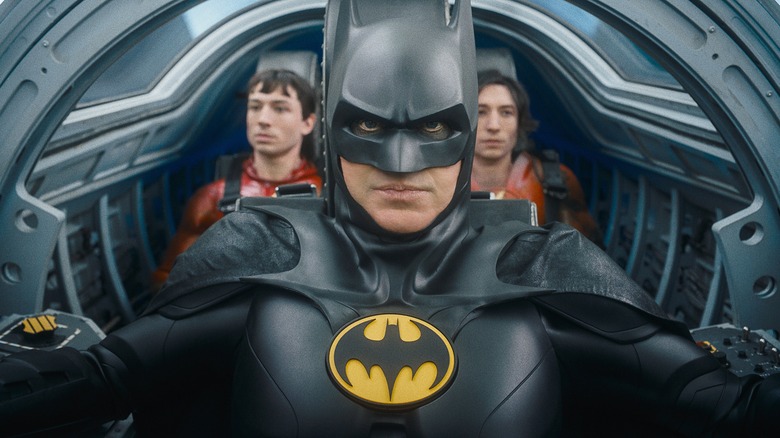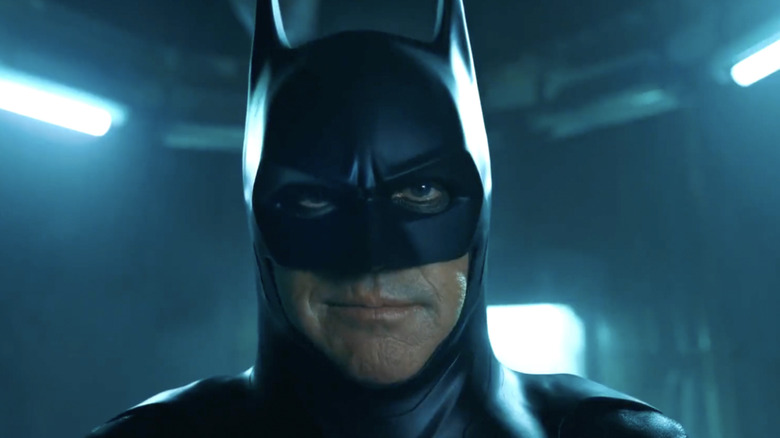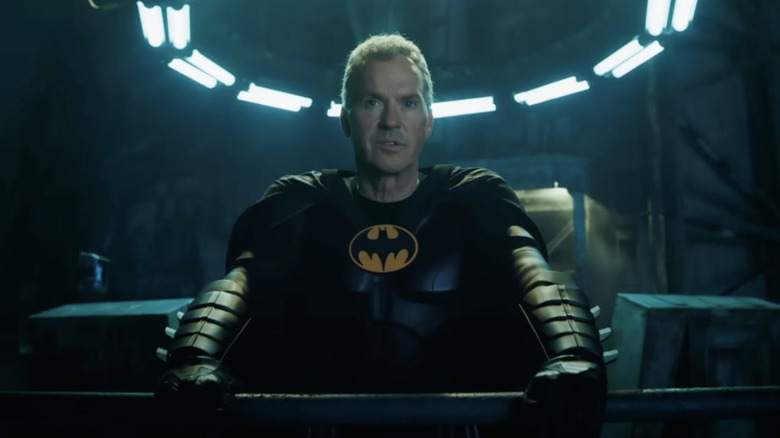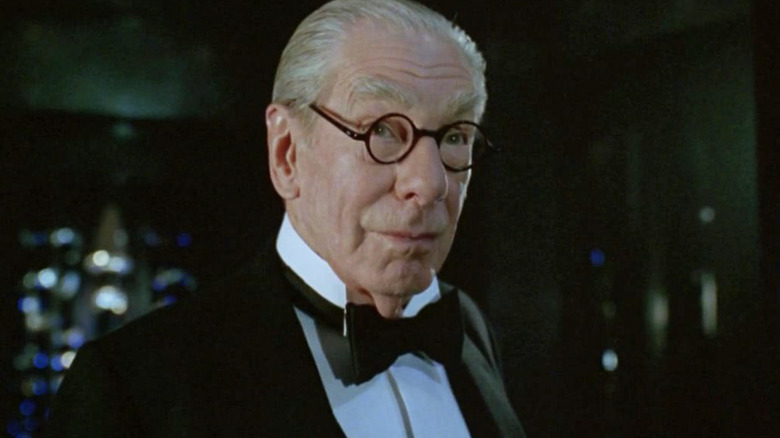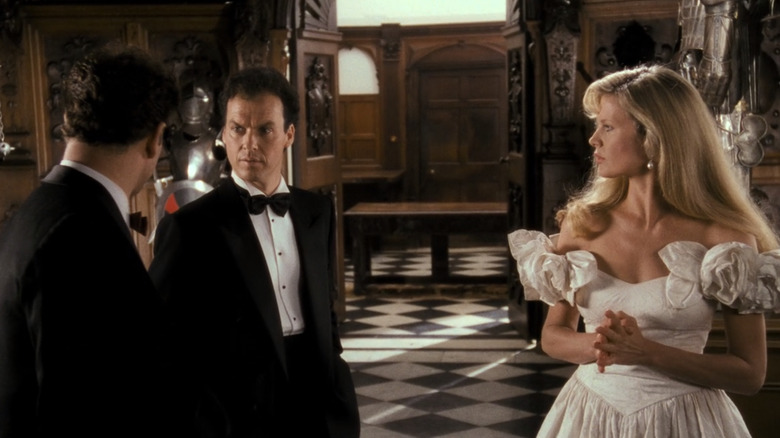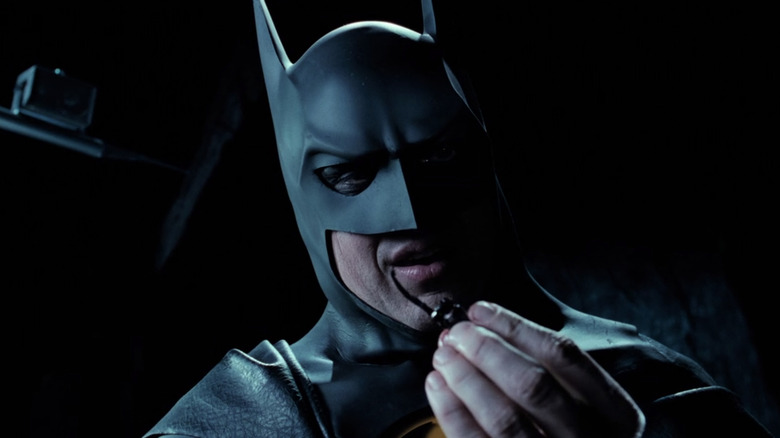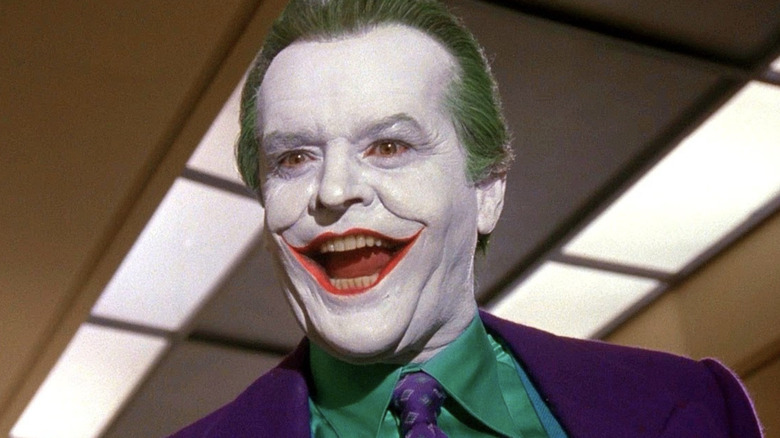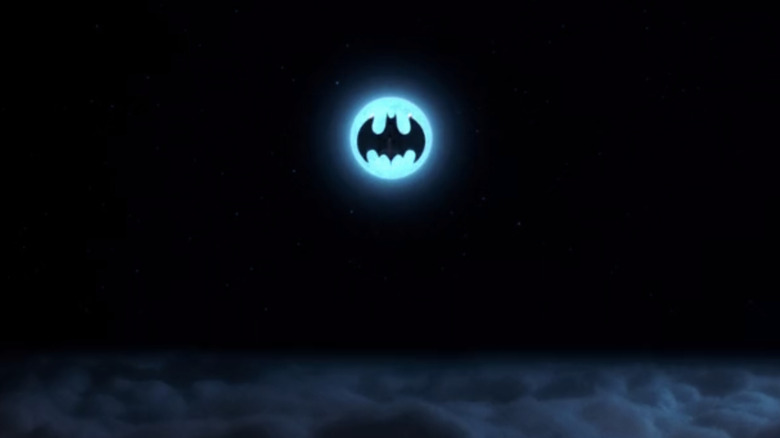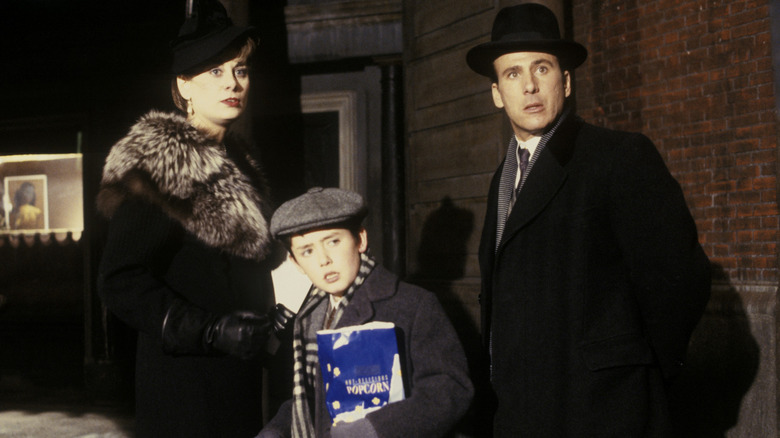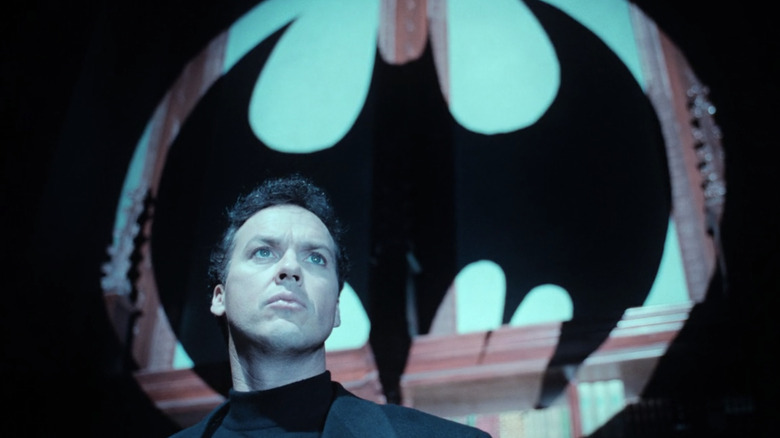The Flash: The Best Callbacks To Michael Keaton's Batman Movies
Contains spoilers for "The Flash"
After over 30 years away from the cowl, Michael Keaton is back as Batman. Having played the character in both of Tim Burton's "Batman" flicks in the late '80s and early '90s, Keaton may be a bit out of practice, but, just like his Bruce Wayne, he can easily jump back into the swing of things. While many have claimed the mantle as their own since Keaton stepped down from the "Batman" series, none inspired the same sort of fanaticism as Michael Keaton's version of the character. In fact, he's the first live-action Batman to return after such an absence, with plenty of fanfare surrounding his revival in "The Flash."
Although Keaton was directed by Tim Burton the first time around, this time director Andy Muschietti takes a turn with the character, thrusting him into a world full of meta-humans and aliens alike. Starring opposite Ezra Miller's Barry Allen aka The Flash, Keaton's Batman proves himself as resourceful as any other Batman, fitting in nicely with the newly-fractured timeline. As capable and valiant as ever, Batman aids the Flash in his quest to fix the timeline and save the multiverse, something we never thought we'd see from Keaton's Caped Crusader.
While it's unlikely that Keaton's Batman will return again after "The Flash," stranger things have certainly happened. With the existence of multiple timelines and universes, it's entirely possible that another Batman could exist out there with Keaton's features. But until then, let these callbacks to the original "Batman" movies hold you over.
'I'm Batman'
The first time Batman appears in the original 1989 Tim Burton film, he takes out a couple of thugs on a darkened rooftop, stepping confidently out from the shadows. It doesn't take long for Batman to dispatch his adversaries, and when posed with the question of his identity, the Dark Knight growls his iconic line, "I'm Batman." From then on, "Batman" unveils its titular hero as a mythical figure, protecting Gotham City while cloaked in mystery.
The tagline has often been associated with Keaton's version of the character, who paved the way for just about every other incarnation since. Others, such as Christian Bale in "Batman Begins," have uttered the same phrase, but none with the same gravitas and style as Michael Keaton. This being Keaton's most quotable line and all, it isn't a surprise that it's uttered again in "The Flash." It's a welcome callback, indeed.
Though it was first revealed in the film's trailers, the line is a bit more exciting to hear on the big screen. The moment marks when the reclusive and retired Bruce Wayne — not unlike Frank Miller's "The Dark Knight Returns" – decides to reprise his role as Batman, helping the Flashes defeat General Zod and his army of Kryptonians. With that one line, Keaton commands our attention and ushers himself back in as Batman — acting almost as if he'd never left in the first place. Yeah, he's Batman, alright.
'Let's get nuts'
Since the release of the first "Batman," there's been some question as to whether or not the Michael Keaton version of Bruce Wayne is entirely sane. "Why would an incredibly rich guy want to put on a weird suit and beat up petty crooks?," screenwriter Sam Hamm asked Comics Alliance rhetorically. "I mean, he'd have to be crazy, right?" It's certainly a question worth exploring, and while "The Flash" doesn't give us any clear-cut answers, it entertains the notion.
After Barry gets back his own powers and Supergirl returns to help the group defeat Zod, Batman offers his help with the line, "You wanna get nuts? Let's get nuts." Longtime fans of the original "Batman" movies may recognize that quote instantly from Tim Burton's first superhero feature, when Bruce Wayne defends Vicki Vale from the Joker, trying to catch the Clown Prince of Crime off-guard. Rather than suspect that Bruce is indeed Batman, Joker shoots him and leaves the scene. Thankfully, Bruce is fine, but he begins to put together the identity of his adversary and eventually battles the homicidal clown.
Though the line's usage in "The Flash" is meant to signal his decision to help the Fastest Men Alive, it might be a nod to his mental health — he nearly killed the Barrys upon their first meeting after all. With plenty of trauma stored in his utility belt, Keaton's Batman is likely unbalanced after decades of crime-fighting.
Alfred Pennyworth
At the beginning of "The Flash," Barry is called to action by Batman's butler Alfred Pennyworth (played by Jeremy Irons) after he first attempted to call other Justice Leaguers to help with a disaster in Gotham City. While Ben Affleck's Batman and Gal Gadot's Wonder Woman save the day, the Flash saves the lives of a half-dozen infants caught in the crossfire. It's quickly made clear that, without Alfred, Affleck's Batman would struggle to do as much good as he does for the world, and yet, not every Batman still has an Alfred by his side.
In the altered timeline that Barry creates by saving his mother, it's revealed that Michael Keaton's Batman lost his Alfred years ago, and he's been alone ever since. While it's not explained if Alfred retired or passed away, it's more than likely that the butler died sometime between the events of "Batman Returns" (set in 1992) and "The Flash" (largely set in 2013).
While the reference to Alfred is touching in itself, Barry's discovery of an engraved pen with Alfred's name on it is more likely a reference to the fact that this is the only time Keaton has played Batman without Michael Gough playing Alfred beside him. Gough died in 2011, just two years before the start of the DCEU. "To Mick — my butler, my confidant, my friend, my Alfred. I love you. God bless," wrote Keaton following Gough's death (via Digital Spy).
Wayne Manor
Although the physical appearance of Wayne Manor differs between "Batman" and "Batman Returns," the version from the latter is the one that appears again in "The Flash." Unlike Ben Affleck's decrepit Wayne Manor, Michael Keaton's stands intact, and while it's a bit trashed on the inside, everything's still in order. In fact, one of the most famous places in "Batman" shows up again in "The Flash," which is a room with a checkered floor, full of suits of armor.
In the '89 film, Vicki Vale (Kate Basinger) and Alexander Knox (Robert Wuhl) wander into this armor room, mocking Bruce's strange fascination with warriors from other cultures. Naturally, Bruce shows up and explains his tastes before introducing himself to his "Batman" love interest. From there, Bruce and Vicki spend plenty of time in Wayne Manor, including Alfred's side of the house while on their first official date. Sadly, the armor room doesn't appear again in the sequel.
In "The Flash," the Barrys wander into this same room while looking for Bruce, only to snoop around for a while. Of course, the Bruce Wayne they find isn't exactly the one the original Flash was looking for, but he's a Batman nevertheless. The drastic shift in Wayne Manor between the end of "Justice League" and "The Flash" may have been jarring for casual viewers, but fans of the original "Batman" movies will note not only the change in Batmen, but in their not-so-humble abodes as well.
The classic cowl
In theatrical, live-action adaptations of Batman, the Dark Knight has struggled with turning his head. The iconic cowl often trailed into the hero's cape, making it nigh impossible for the vigilante to look in either direction while in battle. This issue was fixed in Christopher Nolan's "The Dark Knight," when Christian Bale's iteration of Batman specifically requests the change. But, back in Keaton's day, there was only one cowl to be worn, and his Dark Knight was forced to turn his entire body in the fight.
Well, "The Flash" followed suit, reviving the old one-way cowl as Batman's uniform is upgraded from his previous appearance in "Batman Returns" (though his old suits are briefly seen). Thankfully, it seems like Keaton's Batman has had plenty of practice over the years, as he seems more agile than ever. Comparing Batman's action sequences in "The Flash" to those in the Tim Burton films is almost like watching two different Batmen, proving how much he's learned since his last on-screen appearance.
In "The Flash," the younger Barry Allen fashions himself a Flash suit using an old Batman outfit as his initial template, spray-painting it red. Forced to saw off the bat ears, he places the cowl on his head but soon finds that he has trouble moving his neck while turning. As a result, the newer Flash cuts off part of the cowl's base, giving him the ability to turn at ease. It seems like Batman should've thought of that himself years ago.
The Joker's laugh
After the Barry Allen duo makes their way into the Batcave, the younger Barry finds a bag while snooping through Batman's things. When he opens it, a soft but eerie laugh comes through, to the original Barry's annoyance. While it's a quick, throwaway moment, it's a fabulous reference to the ending of the original "Batman." After Batman discovers that the Joker killed his parents all those years ago, long before he became the perma-white clown, they duel to the death at the top of a cathedral.
After Batman prevents Joker from escaping, the Clown Prince of Crime falls to his death, his ankle attached to a gargoyle atop the cathedral. Yes, Batman killed the Joker in their first blockbuster together, but "Batman Returns" implies that he regrets it as he tries to talk Catwoman out of doing something similar. Nevertheless, Commissioner Jim Gordon finds on the Joker's body a bag that holds a set of chattering teeth, making a distorted laughing noise — the same one heard in "The Flash."
It seems that Batman kept this token as a memento of what he'd done, and though Batman doesn't seem too concerned with not killing his enemies in "The Flash," the guilt of taking out his parent's killer might ring a bit differently to the Dark Knight. Either way, it's fun to remember Jack Nicholson's Joker, a villain often overshadowed by Heath Ledger's later performance. Ledger is good, to be sure, but Nicholson had real charm.
'All those wonderful toys'
There's a line in the 1989 "Batman" movie where the Joker asks, "Where does he get all those wonderful toys?" But since Batman's a billionaire, it's not really a tough question to answer. In "The Flash," we're introduced to a variety of new "toys" that Batman uses to rescue Supergirl and battle General Zod, but there are a few older ones worth noting as well. After the two Barry Allens break into the Batcave (which looks just like we remembered), the younger Barry uncovers the iconic Batmobile from the first two films, as stylish as ever.
Tragically, nobody drives the Batmobile this time around, but the Batwing also returns, this time with some major upgrades. Since the original was grounded by the Joker, this newly-improved model features some extra seats, a rotating cockpit, and plenty of onboard weapons to battle alien invaders. In a moment akin to the original "Batman," the Batwing even hovers in front of the moon, creating a sort of Bat signal as Batman and the two Flashes descend on the Siberian prison holding the Girl of Steel.
Along with the bat-themed vehicles are some other bat-themed weapons, including the famous Batarang, which needs no introduction. Batman's grappling hook from the two Tim Burton films makes a reappearance as well. "The Flash" even features shots dedicated solely to explaining where Batman's hook grapples, just like the old "Batman" films.
Thomas & Martha Wayne
"The Flash" is all about grieving one's parents and trying to save them. That's the catalyst for Barry Allen's journey through time, hoping to save his mother from death and his father from being wrongfully imprisoned for her murder. When talking with Bruce Wayne (the Ben Affleck version) before going back in time, Barry adds that he could save not just his parents, but Bruce's too. Wisely, Bruce notes that changing the timeline could have disastrous consequences and that neither of them would be who they were without the scars of their past.
Of course, Barry does it anyway, and in doing so creates a timeline where Bruce Wayne looks a bit different (now played by Michael Keaton), and has a slightly altered history to boot. But, since he's Batman, that means that his parents, Thomas and Martha Wayne, are still dead. In a brief moment as this new Bruce decides if he's going to help the Flash save the world, he glances at a photograph of his younger self alongside his parents. It's a quick moment, but a touching one that reminds him just why he fights in the first place.
Though not a direct reference to the Burton films, this scene echoes the moment in "Batman" when Bruce reflects on his parent's death after re-reading a news clipping about their murder. Similar to the moment in "The Flash," this gives Bruce the resolve he needs to defeat the Joker and ultimately uncover his identity.
The Batman Theme
If there's any one theme that fits Batman to a "T," it's Danny Elfman's "The Batman Theme" from the original Tim Burton film. Sure, Hans Zimmer and Michael Giacchino are wonderful composers, but Elfman's score is something else. On the same emotional level as John Williams' iconic "Superman March" from the old Christopher Reeve "Superman" films, it's the theme that plays in one's head whenever thinking about the Dark Knight. There's no denying that Elfman's score has been massively influential to the character moving forward.
When Warner Bros. was developing "Batman: The Animated Series," they hired Elfman to help with the theme music, which shares similar notes with the movie version. Since then, Elfman's score has been consistently tied with Batman media, including video games, movies, television, and more. After years of an on-screen absence, it resurfaced in the 2017 version of "Justice League" after director Joss Whedon hired Elfman to re-write the score. Now, re-appearing in "The Flash," it feels more natural than ever.
Keaton's Batman is the one most closely associated with the music, and the constant drops of Elfman's theme throughout "The Flash" make it feel as if he's really back under the cowl. Though Burton hasn't returned for another "Batman" feature, and this is likely the last time we'll see Keaton reprise his role, Elfman's score just feels right when watching him beat down criminals and save the day. It certainly wouldn't be a Michael Keaton Batman project without it.
Replacement Batmen
Nothing sums up Michael Keaton's Batman quite like being replaced by the third movie, and Keaton can't even get through his third adventure as the Dark Knight without being swapped out by the end. Though Keaton's Batman replaces Ben Affleck's version from the DCEU before Barry messes up the timeline, once Barry restores things seemingly back to normal, the cowl doesn't automatically go back to the "Batman V Superman" star. Instead, "The Flash" ends with Barry encountering a new Bruce Wayne, this time played by George Clooney.
Clooney famously played Batman in Joel Schumacher's "Batman & Robin," a sequel to "Batman Forever" that saw Val Kilmer in the lead role. While Clooney wasn't Keaton's immediate successor, his return in "The Flash" is an obvious nod to Keaton's Batman being replaced by Schumacher following "Batman Returns" after disagreements about the film's tone.
Ironically, Affleck was likewise replaced. After 2017's "Justice League," plans for Affleck's solo Batman feature fell through, and he was quickly replaced as both director and star by Matt Reeves and Robert Pattinson, who helmed 2022's "The Batman" in his stead — a film that rebooted the Dark Knight once again. In "The Flash," both Affleck and Keaton — who was originally meant to have a larger role in the future DCEU — were passed over in favor of Clooney's Bruce Wayne, who greets the Flash as if nothing was out of the ordinary.
